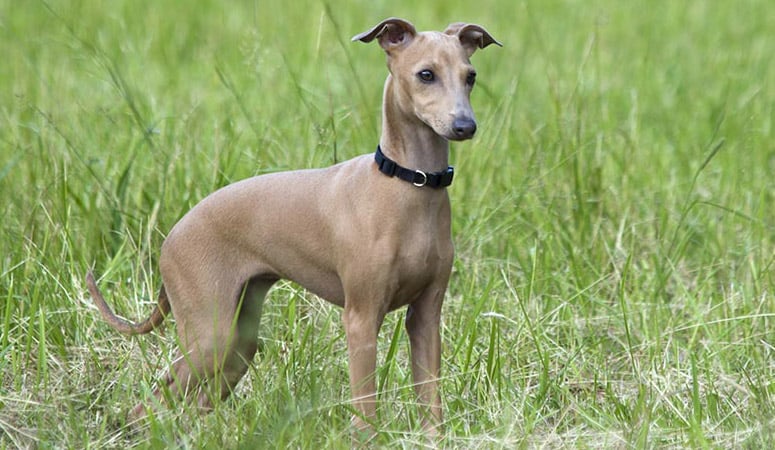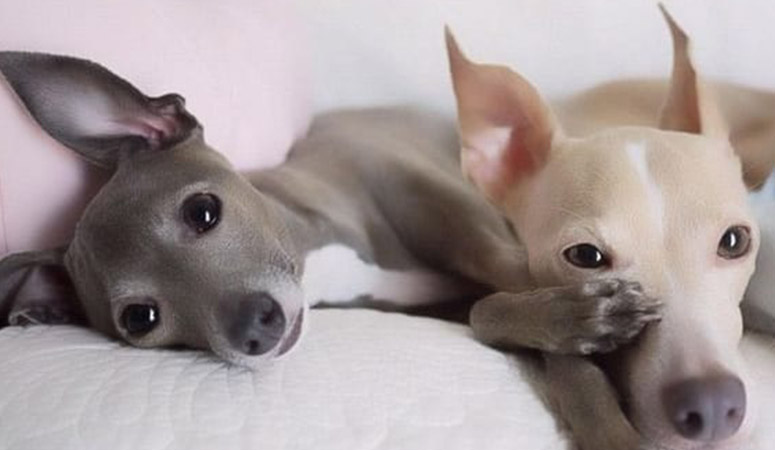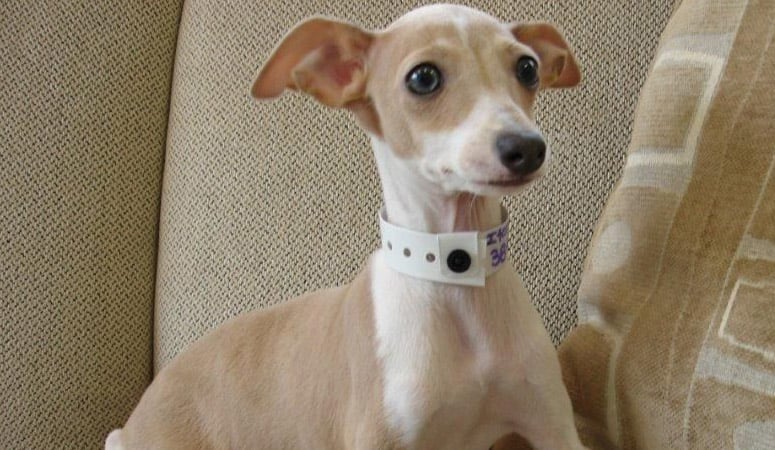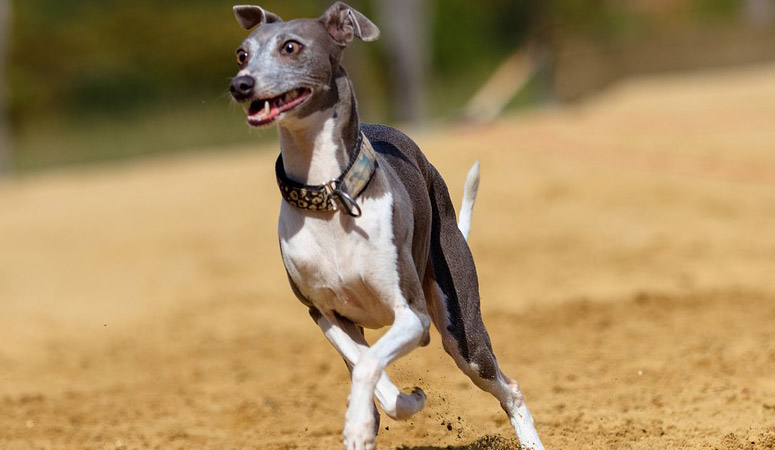Italian Greyhound
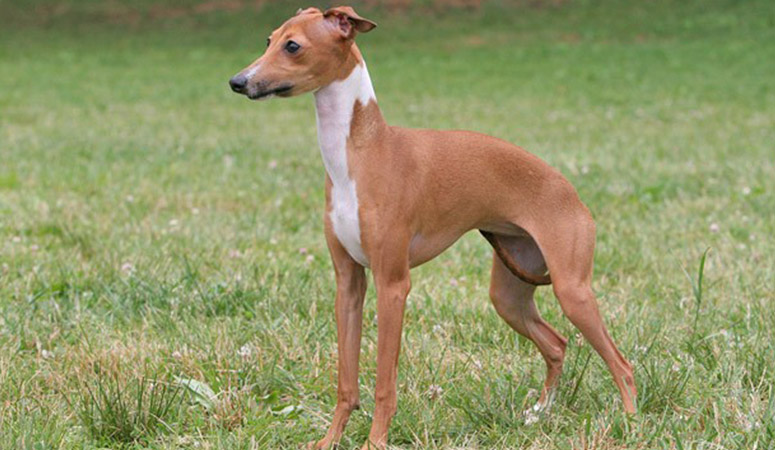
With determination, endurance and speed to hunt small game, the Italian Greyhound makes decorative couch breed with high affection. In the Middle Ages, they are favorite companion of the noblewomen, especially in Italy with long, fine-boned legs. The IGs were bred for centuries to be doting companions and jesters who need special care in cold weather.
| Other Names | Iggy, Piccolo Levriero Italiano |
| Color | Black, Blue, ,Blue Fawn, Cream, Fawn, Red, Sable, Seal, White & Black, White & Blue, White & Fawn |
| Height | Males: 12-15 inches. Females: 12-15 inches. |
| Weight | Males: 8-11 pounds. Females: 8-11 pounds. |
| Life Span | 14-15 years |
| Personality | Playful, Alert, Sensitive |
| Exercise | Regular Exercise |
| Origin |
| Popularity | #67 |
| Groom Needs | Occasional Bath/Brush |
| Kids Friendly | No |
| Dog Friendly | Yes |
| Watch Dog | |
| Family Dog | |
| Litter Size | 3-5 puppies |
Italian Greyhound Pictures
Italian Greyhound Video
Introduction
The Italian Greyhound is a family dog, beloved by many for its beauty and athleticism. Of course, many like to use these dogs for rally competitions as they can reach top speeds of about 25 miles an hour. He is about 15 inches at the shoulders and weighs around 15 pounds. They making loving companions that fit well into a family and they are easy to groom as well. That’s because their hair is short, glossy, and soft. His coat comes in colors such as fawn, cream, red, blue, or black, either solid or with white markings. Like a lot of other dogs, the Italian Greyhound also doesn’t like being left alone as they are highly sensitive dogs, needing plenty of companionship, love, play, and exercise – then see what a devoted pet this makes. Don’t ever leave this pet out in the cold; he loves warmth and does not like being cold or wet. That being said, they are not the easiest of dogs to housetrain, actually never being fully trustworthy inside the house. He has a good deep bark for such a small dog, so that makes him quite a good watchdog. Some breeders don’t sell these dogs to families that have children under 10 because they are small dogs, and children need to be taught to deal gently with such a dog; remembering it needs appropriate handling and is not a toy.
Living with Italian Greyhound
The Italian Greyhound’s coat doesn’t shed much and is easy to care for, but it requires to be brushed when the coat gets dusty and you should bathe your dog if he’s rolled in anything smelly.
Trim nails once or twice a month if your dog doesn’t wear them down naturally to prevent painful tears and other problems. With blood vessels in the toenails, if you cut too far you can cause bleeding — and your dog may not cooperate the next time he sees the nail clippers come out. So you’d better ask a vet or groomer for pointers if you’re not experienced trimming dog nails.
His ears should be checked weekly for redness or a bad odor, which can indicate an infection. If you are going to check your dog’s ears, wipe them out with a cotton ball dampened with gentle, pH-balanced ear cleaner to help prevent infections and just clean the outer ear instead of inserting something into the ear canal.
With elegant high-stepping gaits and small, muscular body, the IGs still retains his instinct for hunting small game and they are easy to chase anything that moves. He has lots of energy and appreciates plenty of opportunities to exercise.
The Italian Greyhound requires plenty of regular exercises to keep energetic, healthy and happy. Their exercise is usually spread throughout the day, punctuated by long naps, preferably on your lap. A fit IG can even make a good jogging partner.
You should spend time every day taking your Italian Greyhound out for a run or walk in an enclosed area, or let it loose at the dog park where it can play with other dogs about two hours each day.
Dog parks can be a hazard unless well supervised and having separate areas for small dogs. Also games and tricks provide needed mental exercise.
Generally, this small breed requires good quality dry dog food each day to keep healthy whether commercially manufactured or home-prepared with your veterinarian’s supervision and approval. But the amount of food that you feed should depend on his metabolism, size, age, and activity level.
Just like people, dogs don’t all need the same amount and quality of food. But the better the dog food, the further it will go toward nourishing your dog.
Very young or small puppies should be fed frequently to prevent low blood sugar. Adult dogs should be provided with a balanced diet, with restricted calories if the dog starts to gain too much weight. To keep the IG in good shape and from obesity, you should feed him twice a day and measure his food, instead leave food out all the time.
Learn about which human foods are safe for dogs, and which are not. Talk to your veterinarian about the optimal diet and quantity of food for your IG.
Generally IGs are healthy, but like all breeds, they’re prone to certain health conditions, such as cataracts, von Willebrand’s disease, vitreous degeneration, progressive retinal atrophy (PRA), hypothyroidism, legg-calve-perthes disease, patellar luxation, hip dysplasia, allergies, epilepsy, cryptorchidism, portosystemic shunt.
It’s important to be aware of them if you’re considering this breed although not all IGs will suffer from all of these diseases.
With the lifespan of 13 to 15 years, Italian Greyhounds are generally long lived. They are not as delicate as they look, but special care should be given to prevent hazardous situations, which may lead to a broken leg.
A responsible breeder should take his dog to check with the vet and screen for health conditions. Some common health tests that should be done regularly include hip evaluation, ophthalmologist evaluation, thyroid evaluation and patella evaluation.
Total Annual Cost: $2941.4
Cost is estimated for the first year and may vary depending on many factors, such as dog food, health care, leash, collar, licensing, possible fencing, crates, training and obedience classes, dog-walking, grooming, treats, toys, flea, tick, and heart-worm meds, microchips, etc.
With intelligence, the IGs are easy to train. The athletic, graceful IG seems built for agility, and many love the sport and do it well. Obedience-trained IGs should not be allowed off lead outdoors in unfenced areas, because small, moving animals are a huge incentive to run, possibly into danger.
Though they are sighthounds, Italian Greyhounds are too fragile for the field and don’t make valuable hunting companions. The breed can shine in dog sports such as obedience training, agility, and rally when well trained.
Reward-based training methods are the best way to get his respond, but harsh methods just don’t work with these intelligent, sensitive little dogs, even though they can be stubborn. The trainer should be firm with commands and lavish with praise.
Housetraining is a little hard for the breed, even some are never completely trustworthy in the house. But they eventually get there as long as training is patient and consistent. And they can learn basic commands quickly if the training is fun and sessions are kept short.
They don’t enjoy alone time, and no amount of behavior training will make them tolerate it peacefully. Too much solo time will make develop separation anxiety, and you can leave it alone at most one or two hour.
History
This lean and lithe little dog originates from Italy.
He was a favorite companion to noblewomen during the Middle Ages when he made his way to southern Europe – hence its name, Italian Greyhound
If you are a lover of art, you might have seen the Italian Greyhound gracing many a century-old portrait. That’s because in early times, he was bred to hunt – today, he still has that hunting instinct.
In Greece and Turkey, there are some archaeological diggings that show them to be the remains of Greyhounds.
They arrived in England around 1600 and Mary Queen of Scots, Queen Victoria, Charles I, to name a few, were great fans of this dog.
The American Kennel Club registered its first Italian Greyhound in 1886.
During World Wars I and II, when dogs and dog breeding were unaffordable to many, the number of the Italian Greyhounds dwindled a lot, but the British breeders made use of the American-bred Italian Greyhounds to restore the breed in Europe.
Helpful Information
Breed Club: ITALIAN GREYHOUND CLUB OF AMERICA, INC.
Breed Club Link: http://italiangreyhound.org/
Breed Club Rescue: Italian Greyhound Rescue Foundation
Breed Club Rescue Link: http://www.igrescue.com/index.shtml

